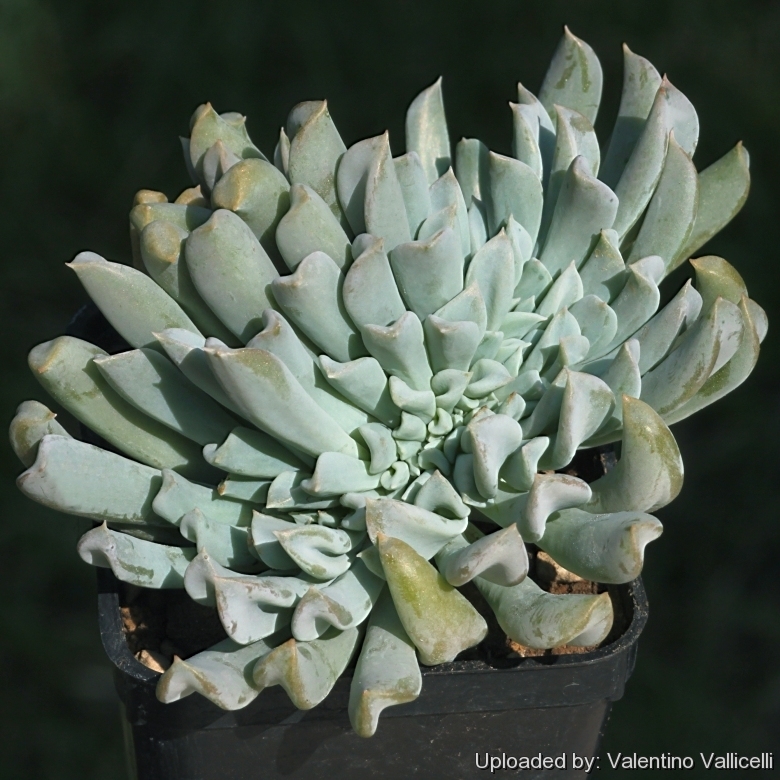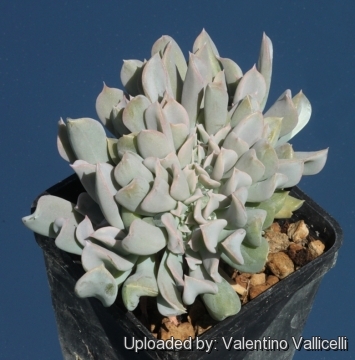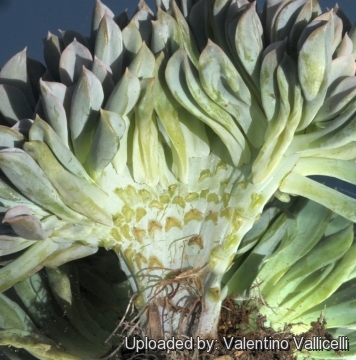
Echeveria runyonii cv. Topsy Turvy f. cristata Photo by: Valentino Vallicelli
Origin and Habitat: This cultivar is a mutation originated in cultivation in California. The standard Echeveria runyoniiSN|21873]]SN|21873]] is found natively in Mexico.
Synonyms:
See all synonyms of Echeveria runyonii
back
Accepted name in llifle Database:Echeveria runyonii Rose ex E.WaltherCact. Succ. J. (Los Angeles) 7: 69. 1935Synonymy: 2
Cultivars
(2):
back
Description: Echeveria runyoniiSN|21873]]SN|21873]] cv. Topsy Turvy is an interesting leaf form of Echeveria runyoniiSN|21873]]SN|21873]], which is a pale blue to white-blue leaf Echeveria with normal shaped leaves. However, this 'Topsy Turvy' form is much more popular, so the 'regular' form is quite rare in cultivation.
Crested form: The rare crested form produces magnificent, fun shaped silvery, leaf rosettes and may assumes many fascinating shapes
Leaves: Up to 7,5 cm long by 2,5 cm across. Blue-green to silvery-grey often with pink tips, spatulate, strongly inversely keeled on the lower surface with leaf tips pointing inwards towards the centre of the plant. This leaves are some of the most unique curling and twisting leaves among the Echeverias, looking as if they are turned inside out.
Flowers: Showy bright orange, apricot and pink on tall arching racemes.
Blooming season: Usually in late Summer Autumn.
Subspecies, varieties, forms and cultivars of plants belonging to the Echeveria runyonii group
 Echeveria runyonii cv. Topsy Turvy f. cristata Photo by: Valentino Vallicelli
Echeveria runyonii cv. Topsy Turvy f. cristata Photo by: Valentino Vallicelli Echeveria runyonii cv. Topsy Turvy f. cristata Photo by: Valentino Vallicelli
Echeveria runyonii cv. Topsy Turvy f. cristata Photo by: Valentino VallicelliCultivation and Propagation: Echeveria runyoniiSN|21873]]SN|21873]] cv. Topsy Turvy f. cristata can tolerate sun to shade but - generally speaking - the more light a plant gets the better it will display its colours and shape. However, when moving plants from lower light conditions into full sun, be wary of sun scorch, most easily avoided by ensuring plants are well-watered before moving them on a cloudy day. They can tolerate extended dry periods and survive drought without the need for watering, but they will grow stronger if they receive adequate moisture during their growing season, ut never allowing the plant to remain waterlogged (root rot sensitive). Use a very porous soil, which will allow quick drainage. Slow release fertilisers with a low to moderate nitrogen content are adequate for the spring and summer growing seasons, and additional fertiliser applications would not required until spring. Good air movement is important for minimising pest and disease risks, and avoiding excessive humidity in cool winter conditions is important to successfully growing Echeveria in the nursery environment. It can tolerate light frosts, but it is best overwintered at 5-10 °C.
With the cooler autumn temperatures tending to make their foliage colours become more intense than those of the active summer growing season.
Aphids like this plant (and all flowering Echeverias).
Propagation: Echeveria runyoniiSN|21873]]SN|21873]] cv. Topsy Turvy f. cristata can be reproduced only vegetatively. Only a fragment of the crested shoot is used for reproduction because leaves and normal shoots (non-crested) do not produce the crested trait.












